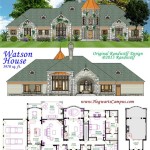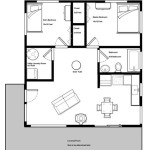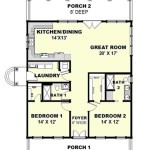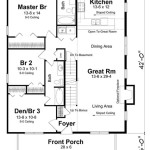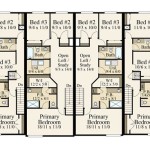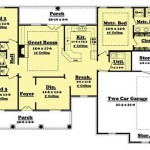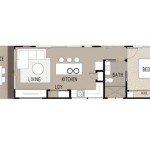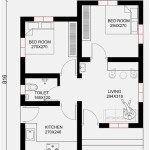Modern House Plans: Optimizing 1800 Sq Ft for Contemporary Living
The design and construction of a modern house requires careful consideration of both aesthetic appeal and functional space. When limited to 1800 square feet, the challenge lies in maximizing every inch to create a comfortable, stylish, and efficient living environment. Modern house plans within this size range often incorporate open-concept layouts, minimalist design principles, and smart storage solutions to achieve a spacious feel and cater to the needs of contemporary lifestyles.
An 1800 sq ft footprint offers a substantial area for a family or individual seeking a balance between comfortable living space and manageable maintenance. This size allows for multiple bedrooms, bathrooms, a dedicated living area, a functional kitchen, and potentially even a home office or entertainment space. The key to successful design lies in strategic space planning and the selection of features that enhance both the usability and visual appeal of the house.
Modern design trends heavily influenced the development of 1800 sq ft house plans. Clean lines, a focus on natural light, and the integration of indoor and outdoor spaces are common characteristics. The use of energy-efficient materials and sustainable building practices is also increasingly prevalent, reflecting a commitment to both environmental responsibility and long-term cost savings.
Key Considerations in Modern 1800 Sq Ft House Plans
Designing a modern house plan within the 1800 sq ft constraint necessitates a focused approach on several essential aspects. Prioritizing needs, understanding spatial relationships, and selecting appropriate materials are crucial for achieving a successful outcome.
Space Planning and Layout: The floor plan is the foundation of any house design. In an 1800 sq ft house, an open-concept layout is often favored to maximize the feeling of spaciousness. This typically involves combining the living room, dining area, and kitchen into a single, flowing space. Strategically positioned windows and doors can further enhance this effect by bringing in natural light and blurring the lines between the interior and exterior.
The number of bedrooms and bathrooms is another critical decision point. A common configuration includes three bedrooms and two bathrooms, offering a comfortable living arrangement for a family. However, the specific needs of the occupants will dictate the optimal layout. A home office or dedicated workspace might be prioritized over a third bedroom for individuals who work remotely. Similarly, the number of bathrooms can be adjusted based on household size and lifestyle.
Consideration must also be given to circulation, the flow of movement throughout the house. A well-designed floor plan will minimize hallways and maximize usable space. Direct access between key areas, such as the kitchen and garage, can improve convenience and functionality. The placement of stairs, if the house has multiple stories, should be carefully considered to avoid obstructing natural light or creating awkward transitions between spaces.
Architectural Style and Aesthetics: Modern architecture is characterized by its clean lines, minimalist aesthetic, and emphasis on functionality. Common design elements include flat or low-pitched roofs, large windows, and a focus on natural materials. The exterior of the house should be visually appealing while also complementing the surrounding environment.
The use of color and texture plays a significant role in achieving the desired aesthetic. Neutral color palettes are often favored for their versatility and ability to create a sense of calm and serenity. Accent colors can be introduced through furniture, artwork, and accessories to add visual interest and personality. The selection of exterior cladding materials, such as brick, stone, wood, or metal, can significantly impact the overall look and feel of the house.
Indoor-outdoor living is a key trend in modern architecture. Incorporating features such as patios, decks, or balconies can extend the living space and create a seamless transition between the interior and exterior. Large sliding glass doors or windows can further enhance this connection, allowing natural light to flood the interior and creating a sense of openness.
Functional Elements and Storage Solutions: Effective storage solutions are essential for maximizing space and maintaining a clutter-free environment in an 1800 sq ft house. Built-in shelving, cabinets, and closets can provide ample storage without sacrificing valuable floor space. Multi-functional furniture, such as sofa beds or ottomans with storage compartments, can further enhance space efficiency.
The kitchen is a focal point of any home, and its design should prioritize functionality and efficiency. A well-designed kitchen will incorporate ample counter space, storage, and modern appliances. An island or peninsula can serve as a central work area and provide additional storage. Maximizing vertical space with tall cabinets and shelving can further enhance storage capacity.
Bathrooms should be designed with both aesthetics and functionality in mind. Space-saving fixtures, such as wall-mounted toilets and vanities, can create a more open and airy feel. Walk-in showers are a popular choice in modern bathrooms, offering a sleek and contemporary look. Adequate storage for toiletries and towels is essential for maintaining a clutter-free environment.
Implementing Energy Efficiency and Sustainability
Modern house plans are increasingly incorporating energy-efficient features and sustainable building practices to reduce environmental impact and lower operating costs. Selecting energy-efficient appliances, using sustainable building materials, and optimizing insulation are key strategies for achieving these goals.
Energy-Efficient Design: Proper insulation is crucial for minimizing heat loss in the winter and heat gain in the summer. Insulating walls, roofs, and floors can significantly reduce energy consumption and improve comfort. Selecting energy-efficient windows and doors can further enhance thermal performance.
Passive solar design principles can also be incorporated to maximize natural heating and cooling. Orienting the house to take advantage of solar gain in the winter and minimizing solar heat gain in the summer can reduce reliance on mechanical heating and cooling systems. Overhangs, awnings, and strategically placed trees can provide shade and reduce the amount of direct sunlight entering the house.
Sustainable Materials: Using sustainable building materials can reduce the environmental impact of construction. Recycled materials, such as reclaimed wood or recycled steel, can be used in place of virgin materials. Locally sourced materials can also reduce transportation costs and emissions.
Bamboo is a rapidly renewable resource that can be used for flooring, cabinetry, and other building components. Cork is another sustainable material that is known for its insulation properties and durability. Using low-VOC (volatile organic compound) paints and finishes can improve indoor air quality and reduce exposure to harmful chemicals.
Renewable Energy Systems: Incorporating renewable energy systems, such as solar panels or wind turbines, can further reduce reliance on fossil fuels. Solar panels can generate electricity for the house, while solar water heaters can provide hot water. The feasibility of these systems will depend on factors such as climate, location, and budget.
Geothermal heating and cooling systems can also be used to regulate the temperature of the house. These systems use the earth's stable temperature to provide heating in the winter and cooling in the summer. While the initial cost of these systems can be higher than traditional heating and cooling systems, they can offer significant long-term energy savings.
Integrating Technology for Enhanced Living
Modern house plans are increasingly incorporating technology to enhance comfort, convenience, and security. Smart home systems can automate various functions, such as lighting, temperature control, and security monitoring.
Smart Home Automation: Smart thermostats can learn your heating and cooling preferences and automatically adjust the temperature to optimize energy efficiency. Smart lighting systems can be controlled remotely and programmed to create different lighting scenes. Smart security systems can provide remote monitoring and alerts in case of intrusion or other emergencies.
Voice-controlled assistants, such as Amazon Alexa or Google Assistant, can be integrated into the home to control various functions through voice commands. These assistants can also provide information, play music, and control other smart devices.
Connectivity and Entertainment: High-speed internet access is essential for modern living. Ensuring that the house is wired for both wired and wireless internet access is crucial. Home theaters and entertainment systems can be integrated into the living area or dedicated media room.
Smart TVs, streaming devices, and surround sound systems can enhance the entertainment experience. Pre-wiring for speakers and other audio-visual equipment can make it easier to install and integrate these systems. Smart home entertainment systems can be controlled remotely using a smartphone or tablet.
Security Systems: Modern security systems offer enhanced protection for homes and families. Wireless security cameras can provide remote monitoring and recording. Door and window sensors can detect unauthorized entry. Smart locks can be controlled remotely and allow for keyless entry.
Motion detectors can trigger alarms and alerts in case of suspicious activity. Security systems can be integrated with smart home automation systems to provide a comprehensive security solution. Professional monitoring services can provide 24/7 protection and emergency response.
Careful planning and execution are essential for creating a modern 1800 sq ft house plan that meets the needs of contemporary living. By prioritizing space planning, aesthetics, energy efficiency, and technology integration, it is possible to create a home that is both stylish and functional.

3 Bedroom 1800 Sq Ft Modern Home Design Bungalow House

House Plan With Structural Drawing 1800 Sqft Design And Designs Books

House Plan With Structural Drawing 1800 Sqft Design And Designs Books

1800 Sq Ft Double Floor Contemporary Home Design Interiors

1800 Square Feet Flat Roof 4 Bhk Home Plan Kerala Design House Front Balcony

1800 Square Feet Home Design Ideas Small House Plan Under Sq Ft

1800 Sqft House Plan Design 30x60 30 By 60

1800 Square Feet Double Floor Contemporary Home Design

3 Bedroom 1800 Sq Ft Modern Home Design Contemporary House Plans Kerala Architect

Farmhouse Style House Plan 3 Beds 2 Baths 1800 Sq Ft 21 451 Houseplans Com

